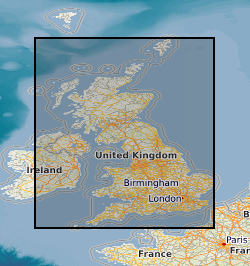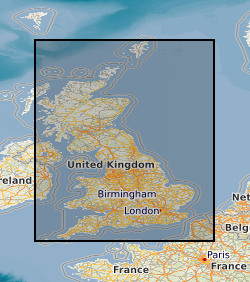ESRI shapefile
Type of resources
Available actions
Topics
Keywords
Contact for the resource
Provided by
Years
Formats
Representation types
Update frequencies
Scale
Resolution
-
Grounding line locations (GLL) data for the Ross and Byrd Glaciers in Antarctica, produced by the ESA Antarctic Ice Sheet Climate Change Initiative (CCI) project. The grounding lines have been derived from satellite observations from theTerraSAR-X platform, acquired between 2011 and 2017.
-

Data identifying landscape areas (shown as polygons) attributed with geological names. The scale of the data is 1:625 000 providing a simplified interpretation of the geology and may be used as a guide at a regional or national level, but should not be relied on for local geology. Onshore coverage is provided for all of England, Wales, Scotland, the Isle of Man and Northern Ireland. Data are supplied as four themes: bedrock, superficial deposits, dykes and linear features (faults). Bedrock geology describes the main mass of solid rocks forming the earth's crust. Bedrock is present everywhere, whether exposed at surface in outcrops or concealed beneath superficial deposits or water bodies. Geological names are based on the lithostratigraphic or lithodemic hierarchy of the rocks. The lithostratigraphic scheme arranges rock bodies into units based on rock-type and geological time of formation. Where rock-types do not fit into the lithostratigraphic scheme, for example intrusive, deformed rocks subjected to heat and pressure resulting in new or changed rock types; then their classification is based on their rock-type or lithological composition. This assesses visible features such as texture, structure, mineralogy. Superficial deposits are younger geological deposits formed during the most recent geological time; the Quaternary. These deposits rest on older rocks or deposits referred to as bedrock. The superficial deposits theme defines landscape areas (shown as polygons) attributed with a geological name and their deposit-type or lithological composition. The dykes theme defines small, narrow areas (shown as polygons) of a specific type of bedrock geology; that is igneous rocks which have been intruded into the landscape at a later date than the surrounding bedrock. They are presented as an optional, separate theme in order to provide additional clarity of the bedrock theme. The bedrock and dykes themes are designed to be used together. Linear features data (shown as polylines) represents geological faults at the ground or bedrock surface (beneath superficial deposits). Geological faults occur where a body of bedrock has been fractured and displaced by large scale processes affecting the earth's crust (tectonic forces). The faults theme defines geological faults (shown as polylines) at the ground or bedrock surface (beneath superficial deposits). All four data themes are available in vector format (containing the geometry of each feature linked to a database record describing their attributes) as ESRI shapefiles and are delivered free of charge under the terms of the Open Government Licence.
-

The 5km Hex GS Running Sand dataset shows a generalised view of the GeoSure Running Sand v8 dataset to a hexagonal grid resolution of 64.95km coverage area (side length of 5km). This dataset indicates areas of potential ground movement in a helpful and user-friendly format. The rating is based on a highest level of susceptibility identified within that Hex area: Low (1), Moderate (2), Significant (3). Areas of localised significant rating are also indicated. The summarising process via spatial statistics at this scale may lead to under or over estimation of the extent of a hazard. The supporting GeoSure reports can help inform planning decisions and indicate causes of subsidence. The Running Sand methodology is based on the BGS Digital Map (DiGMapGB-50) and expert knowledge of the behaviour of the formations so defined. This dataset provides an assessment of the potential for a geological deposit to show running sand behaviour under the action of flowing water, a characteristic usually of saturated sand and silt grade material. Complete Great Britain national coverage is available.
-
This dataset consists of stock (length) data for linear features across Great Britain in 1998 in a vector format. The data are national estimates generated by analysing the sample data from 569 1km squares surveyed for the Countryside Survey long term monitoring project, then scaling up to a national level. The data are presented as mean lengths per 1km square for seven different feature categories within 45 different land class types, based on the ITE Land Classification. The Countryside Survey is a unique study or 'audit' of the natural resources of the UK's countryside, carried out by the Centre for Ecology & Hydrology. The sample sites are chosen from a stratified random sample, based on a 15 by 15 km grid of GB. Surveys have been carried out in 1978, 1984, 1990, 1998 and 2007 with repeated visits to the majority of squares. The countryside is sampled and surveyed using rigorous scientific methods, allowing us to compare new results with those from previous surveys. In this way we can detect the gradual and subtle changes that occur in the UK's countryside over time. In addition to linear features, habitat areas, species plot, soil plot, freshwater habitat and satellite map data are also produced by Countryside Survey. Full details about this dataset can be found at https://doi.org/10.5285/6bc0ccb4-63c8-4121-bc4b-3c479877cff9
-
The dataset consists of pH values from soil samples taken in Roudsea Wood National Nature Reserve in 1961. Soil samples were taken from between 5 and 10cm in depth from transects across the reserve and from under oak trees. pH was measured by the Woodlands Research Section at The Nature Conservancy's Merlewood Research Station, Grange over Sands, Cumbria and the data have been stored and digitised by the Centre for Ecology & Hydrology, Lancaster. Full details about this dataset can be found at https://doi.org/10.5285/1b977181-a3bf-4535-b38e-32509001f7aa
-
This dataset consists of change data for areas of Broad Habitats across Great Britain between 1990 and 2007. The data are national estimates generated by analysing the sample data from up to 591 1km squares and scaling up to a national level. The data are summarized as percentage increase or decrease in habitat area per Land Class (areas of similar environmental characteristics) and are in a vector format. The sample sites are chosen from a stratified random sample, based on a 15 by 15 km grid of GB and using the 'ITE Land Classification' as a method of stratification. The data were collected as part of Countryside Survey, a unique study or 'audit' of the natural resources of the UK's countryside. The Survey has been carried out at regular intervals since 1978 by the Centre for Ecology & Hydrology. The countryside is sampled and surveyed using rigorous scientific methods, allowing us to compare new results with those from previous surveys. In this way we can detect the gradual and subtle changes that occur in the UK's countryside over time. Surveys have been carried out in 1978, 1984, 1990, 1998 and 2007 with repeated visits to the majority of squares. In addition to habitat areas, vegetation species data, soil data, linear habitat data, and freshwater habitat data are also gathered by Countryside Survey. Full details about this dataset can be found at https://doi.org/10.5285/4af5abe4-158a-4736-b318-ec660e09e45a
-
Distribution of soil parent materials in the Severn and Wye catchments. These were mapped during the Soil Hydrology Study conducted by JP Bell in 1968-1969: Bell, J.P. (1969). The Soil Hydrology of the Plynlimon Catchments. Institute of Hydrology Report No. 8, Institute of Hydrology, Wallingford, UK.
-
This dataset consists of stock (length) data for linear features across Great Britain in 2007 in a vector format. The data are national estimates generated by analysing the sample data from 591 1km squares surveyed for the Countryside Survey long term monitoring project, then scaling up to a national level. The data are presented as mean lengths per 1km square for seven different feature categories within 45 different Land Class types, based on the ITE Land Classification. The Countryside Survey is a unique study or 'audit' of the natural resources of the UK's countryside, carried out by the Centre for Ecology & Hydrology. The sample sites are chosen from a stratified random sample, based on a 15 by 15 km grid of GB. Surveys have been carried out in 1978, 1984, 1990, 1998 and 2007 with repeated visits to the majority of squares. The countryside is sampled and surveyed using rigorous scientific methods, allowing us to compare new results with those from previous surveys. In this way we can detect the gradual and subtle changes that occur in the UK's countryside over time. In addition to linear features, habitat areas, species plot, soil plot, freshwater habitat and satellite map data are also produced by Countryside Survey. Full details about this dataset can be found at https://doi.org/10.5285/fc65177d-b113-420e-a70b-05d3f42682d5
-
Elevation contour lines within the Severn catchment at 10 metre intervals. Digitised from the scanned topographic maps.
-
This dataset consists of change data for areas of Broad Habitats across Great Britain between 1998 and 2007. The data are national estimates generated by analysing the sample data from up to 591 1km squares and scaling up to a national level. The data are summarized as percentage increase or decrease in habitat area per Land Class (areas of similar environmental characteristics) and are in a vector format. The sample sites are chosen from a stratified random sample, based on a 15 by 15 km grid of GB and using the 'ITE Land Classification' as a method of stratification. The data were collected as part of Countryside Survey, a unique study or 'audit' of the natural resources of the UK's countryside. The Survey has been carried out at regular intervals since 1978 by the Centre for Ecology & Hydrology. The countryside is sampled and surveyed using rigorous scientific methods, allowing us to compare new results with those from previous surveys. In this way we can detect the gradual and subtle changes that occur in the UK's countryside over time. Surveys have been carried out in 1978, 1984, 1990, 1998 and 2007 with repeated visits to the majority of squares. In addition to habitat areas, vegetation species data, soil data, linear habitat data, and freshwater habitat data are also gathered by Countryside Survey. Full details about this dataset can be found at https://doi.org/10.5285/d83a0f9e-00c9-4d2d-9d0a-e92a16dcb334
 NERC Data Catalogue Service
NERC Data Catalogue Service